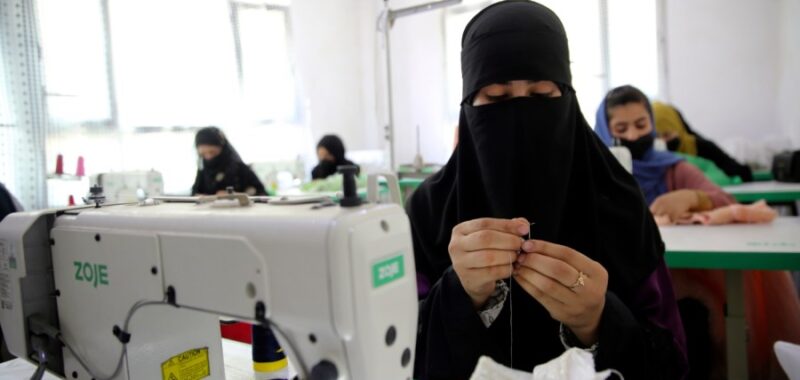
Three years ago, the U.S. and its allies evacuated thousands of Afghans who had worked with them during the war against the Taliban. But the women and girls who remain in Afghanistan now live under a gender apartheid system.
Gender apartheid is not defined in international law, nor is it considered as part of U.S. asylum and refugee law: But it should be.
In Afghanistan today women live under a barbaric system of repression. The Taliban have stripped women of their human rights, freedom and dignity. They use intimidation, violence and the methodical issuance of edicts to keep women in their homes, invisible and with no opportunity to live a full life.
Taliban restrictions affect every aspect of women’s lives — from basic participation in society to education, employment and access to justice. The Taliban most recently banned women’s voices and bare faces in public. Outside of the home, women must cover their faces and bodies entirely and be accompanied by male relatives.
Shortly after taking power in Afghanistan, the Taliban banned girls from attending secondary school. Directives about education have worsened over time. The Taliban ordered gender-segregated classrooms, then limited the subject areas women could study and finally excluded female students from universities.
In the workforce, the Taliban have forbidden women from holding decision-making and managerial positions. Women are also prohibited from running certain businesses and cannot serve as lawyers, judges or in other positions in the justice system.
Since taking over Afghanistan, the Taliban have stopped institutional and legal support for women facing gender-based violence. As a result, more women and girls suffer domestic violence, exploitation and abuse, including forced marriages and child marriages.
The Taliban have issued more than 80 edicts, directives and statements that target and segregate women, restrict their rights and discriminate against them. If women violate these rules, they can be flogged, stoned, arrested or killed.
The situation for women in Afghanistan mirrors the situation of Black South Africans under apartheid — institutionalized regimes of systematic oppression and domination. And the elements of a gender apartheid definition would approximate the elements of apartheid in the Apartheid Convention — if “gender” were substituted for “race” and “Afghanistan” for “South Africa.”
In October, the United Nations’ Sixth Committee is scheduled to consider draft articles for a Crimes Against Humanity Convention. As part of its deliberation, it should add language to the treaty to include gender apartheid. We must join with Afghan women, international legal practitioners and human rights activists to advocate for United Nations member states to act and codify gender apartheid in international law.
Codifying gender apartheid in international law would not move the Taliban to end its gender apartheid system. But it should move countries to take increased, collaborative action, as they did in the 1990s with South Africa.
The collaborative effort should include increased diplomatic and economic sanctions, criminal sanctions for violations of international law and support for Afghan women, thus layering and compounding the alienation of the Taliban, and inhibiting its evasion of accountability.
In support of Afghan women, countries must offer more protection for those who seek safety outside of Afghanistan.
In January 2023, the European Union Agency for Asylum (EUAA) issued guidance that women are in general at risk of persecution in Afghanistan, and thus are eligible for refugee status. Several European countries now recognize all Afghan women and girls outside the country as refugees.
Under current U.S. immigration law, which has traditionally focused on individual status determinations for refugees and asylees, the guidance could not be easily replicated.
However, Congress could accelerate and simplify refugee or asylum recognition for Afghan women and girls. Congress could amend the definition of a refugee as it did in 1996 for victims of China’s One Child Policy.
It could deem any woman who has lived under the Taliban’s gender apartheid system or who fears returning there as having been persecuted or having a well-founded fear of persecution, and meeting the refugee definition based on membership in a particular social group.
Congress could also amend the eligibility for a special immigrant visa. It could not only include eligible Afghans who were employed by the U.S. government but also women living under the Taliban’s gender apartheid system.
Aside from changes in U.S. law, which would face political and legal challenges, the U.S. government could modify policy. Afghan women and girls could be given priority consideration for refugee status.
As a group of special humanitarian concern, Afghan women should have access to the U.S. refugee system by virtue of their circumstances and need for resettlement. Although the U.S. government has prioritized Afghans who assisted with the war against the Taliban, Afghan women as a group need protection.
Gender apartheid is an all-encompassing violation of human rights. It should be codified in international law to activate governments to hold the Taliban regime to account and to offer support for the determination that any woman living under the Taliban’s gender apartheid system or in fear of being returned there is a prima facie refugee in need of protection.
AnnaMarie Bena is the senior vice president of the U.S. Committee for Refugees and Immigrants. She previously served as the director of policy in the Office of Refugee Resettlement at the U.S. Department of Health and Human Services.

